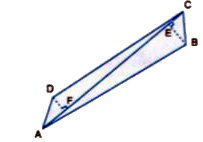In Δ ABC, BP and CQ are perpendiculars from B and C to the opposite sides. If AB = 16 cm. AC= 24 cm, and CQ=20.4cm, find BP.
The correct Answer is:QS=6cm,SR=8cm
To find the length of BP in triangle ABC, we can use the relationship between the areas formed by the perpendiculars from points B and C to the opposite sides.
1. Identify the Given Values:
- AB = 16 cm
- AC = 24 cm
- CQ = 20.4 cm
- We need to find BP.
2. Understanding the Area of Triangle:
The area of triangle ABC can be calculated using two different pairs of base and height:
- First Pair: Base = AB and Height = CQ
- Second Pair: Base = AC and Height = BP
3. Area Formula:
The area of a triangle is given by the formula:
Area=12×Base×Height
4. Set Up the Area Equations:
From the first pair (AB and CQ):
Area=12×AB×CQ=12×16×20.4
From the second pair (AC and BP):
Area=12×AC×BP=12×24×BP
5. Equate the Areas:
Since both expressions represent the area of the same triangle, we can set them equal to each other:
12×16×20.4=12×24×BP
6. Cancel Out 12:
We can cancel 12 from both sides:
16×20.4=24×BP
7. Calculate 16×20.4:
16×20.4=326.4
8. Solve for BP:
Now, we can solve for BP:
326.4=24×BP
Dividing both sides by 24:
BP=326.424
9. Perform the Division:
BP=13.6 cm
Final Answer:
BP = 13.6 cm
- AB = 16 cm
- AC = 24 cm
- CQ = 20.4 cm
- We need to find BP.
The area of triangle ABC can be calculated using two different pairs of base and height:
- First Pair: Base = AB and Height = CQ
- Second Pair: Base = AC and Height = BP
The area of a triangle is given by the formula:
Area=12×Base×Height
From the first pair (AB and CQ):
Area=12×AB×CQ=12×16×20.4
Area=12×AC×BP=12×24×BP
Since both expressions represent the area of the same triangle, we can set them equal to each other:
12×16×20.4=12×24×BP
We can cancel 12 from both sides:
16×20.4=24×BP
16×20.4=326.4
Now, we can solve for BP:
326.4=24×BP
Dividing both sides by 24:
BP=326.424
BP=13.6 cm
BP = 13.6 cm
Topper's Solved these Questions
Similar Questions
In ΔABC,AD and CE are perpendiculars from A and C on the opposite sides. If AD=6cm.BC=14cm,AB=10cm,find CE.
View SolutionIn ΔABC, perpendiculars AP and CQ are droped from vertices A and C on opposite sides BC and AB, respectively. If AB=10cm,BC=16cm,AP=8.8cm, find PQ .
View SolutionAngle BAC of triangle ABC is obtuse and AB = AC. P is a point in BC such that PC = 12 cm. PQ and PR are perpendiculars to sides AB and AC respectively. If PQ = 15 cm and PR = 9 cm, find the length of PB.
View SolutionConstruct an Δ ABC with sides AB = 5 cm, BC = 5.5 cm, and CA = 6 cm.
View SolutionIn a pentagon ABCDE , DP is drawn perpendicular to AB and is perpendicular to CE also at point Q . If AP = BP = 12 cm EQ = CQ = 8 cm . DE = DC = 10 cm and DP = 18 cm . Find the area of the pentagon ABCDE .
View SolutionIn ΔABC,D and E are the points on sides AB and AC respectively.
Find whether DE || BC, if :
AB = 9 cm, AD = 4 cm, AE = 6 cm and EC = 7.5 cm.
View SolutionFind the area of a quadrilateral ABCD whose diagonal AC is 25 cm long and the lengths of perpendiculars from opposite vertices B and D on AC are BE = 3.6 cm and DF = 2.4 cm .

View SolutionIf in ΔABC,b=3cm,c=4cm and the length of the perpendicular from A to the side BC is 2 cm, then how many such triangle are possible ?
View SolutionABC is a right angled triangle with ABC=90∘. D is any point on AB and DE is perpendicular to AC. Prove that:

If AC = 13 cm, BC = 5 cm and AE = 4 cm. Find DE and AD.
View SolutionFind the area of a triangle whose sides are 12 cm, 16 cm and 20 cm.
View Solution

